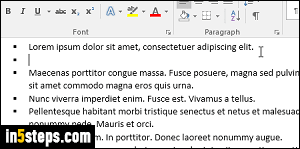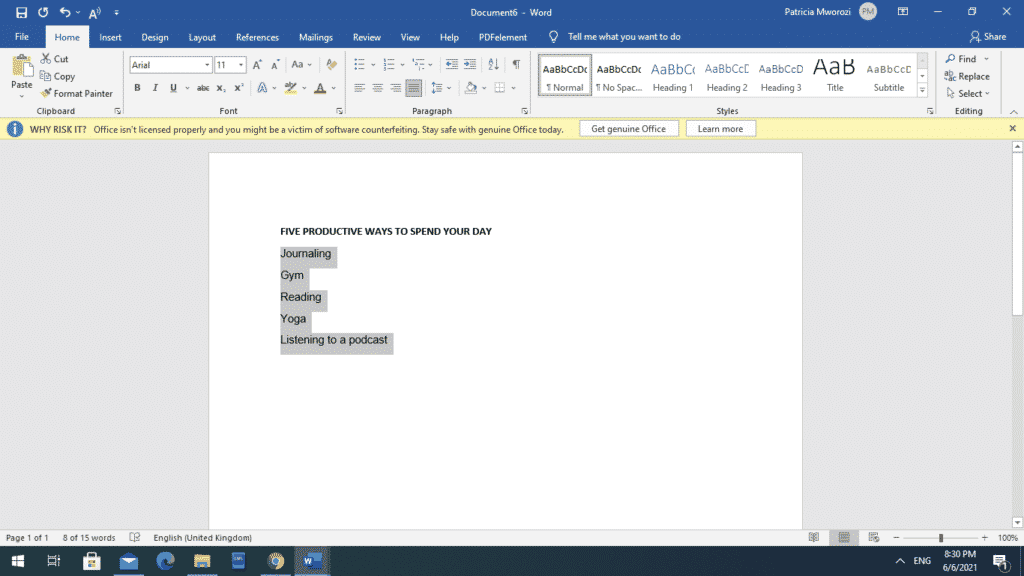
Manually change your line spacing in your program tools. Use program tools to set your line spacing This will ensure you have enough room to set your page for single-spaced or 1.5-point line spacing, keeping your text united and balanced. The side margins should be no less than 0.75 inches. Generally, the top and bottom margins of the page should be no more than 0.5 inches. Your word processor should have the option to set your own margins, or you can leave what the program sets automatically. Set your page's margins to use all the space that's available to you. Similarly, in a two-column resume, ensure that the left-most column is aligned to the left and that the right-hand column is either right-aligned or text-justified. You can also align your headings to the left, but if you are using a plain font with plenty of white space, consider aligning your header text in the center to make it stand out. For example, if your resume is a one-page resume with the general sections for your objective or summary, work experience, education, skills and other credentials, align the main text to the left. Align each section of your resumeĮnsure each section of your resume is aligned according to the format you're using. Line breaks help each section flow into the next, while highlighting each aspect of your qualifications for the job. You can do this by hitting "enter" on your keyboard twice to insert a blank line between sections, or you can insert a horizontal line through your word processor's functions. Use line breaks to create an alignment effect between each section of your resume. This will help create cohesiveness between each line of text, whether it's a section heading or a list of your accomplishments. Then, for the body text of each section (like your job duties under your work experience), you can set your line spacing back to single-spaced. For example, create a larger line space between headers (like your section headings) and the following text, such as a 1.5-point line spacing. Use your resume line spacing to create a balance of white space between sections, headings and each line of your resume sections. Make use of the white space on your resume Several excellent fonts that provide readability and that are compatible across platforms include Arial, Times New Roman, Verdana, Georgia and other mono- and serif fonts. Instead, choose a font that allows for readability with traditional single line spacing. Consider the size of your fontsĪvoid fonts that are decorative in nature, such as calligraphic and formal scripts, as these types of fonts can affect how your text appears between each line. The line spacing of a traditional resume format is usually single-spaced, and this provides enough space for all of your information while keeping the text clear and legible. Typically, a classic or traditional resume format that includes distinctive sections like your skills, work experience and education is the best choice to go with, no matter the industry. Use a resume format that is appropriate to the industry or role you're applying for. Use the following approaches to format your resume line spacing so that your key skills and qualifications stand out to employers: 1.
How to adjust bullet point spacing in word how to#
Related: Resume Format Guide: Tips and Examples of the Best Formats How to format your resume line spacing For instance, proper spacing between the bullet points you include in your work experience section will make each of your past responsibilities stand out more clearly and legibly and will be easily scannable by both an employer and ATS software.

That said, your resume line spacing can be advantageous in making your key skills and qualifications stand out right away. To add to that, many employers use applicant tracking systems (ATS for short) and usually spend no more than a few seconds scanning a single resume.

The amount of space you leave between headings, sentences and the sections of your resume can have an impact on how likely it is an employer will continue reading your resume after skimming through. The line spacing on your resume can mean the difference between clearly legible print and coherent resume sections and unclear spacing and an disorganized appearance.

Related: How to Write a Resume Employers Will Notice Why is line spacing on a resume important? In this article, we'll discuss the importance of resume line spacing and how you can format your line spacing to create a cohesive and easily scannable resume that employers will notice. From spacing your headers and body text to inserting line breaks in the right spot, resume line spacing can affect the appearance of your resume. However, your resume line spacing is equally as important as the information you put into it. Formatting your resume to showcase your best skills, your experience and qualifications is essential in making an impression on employers.


 0 kommentar(er)
0 kommentar(er)
